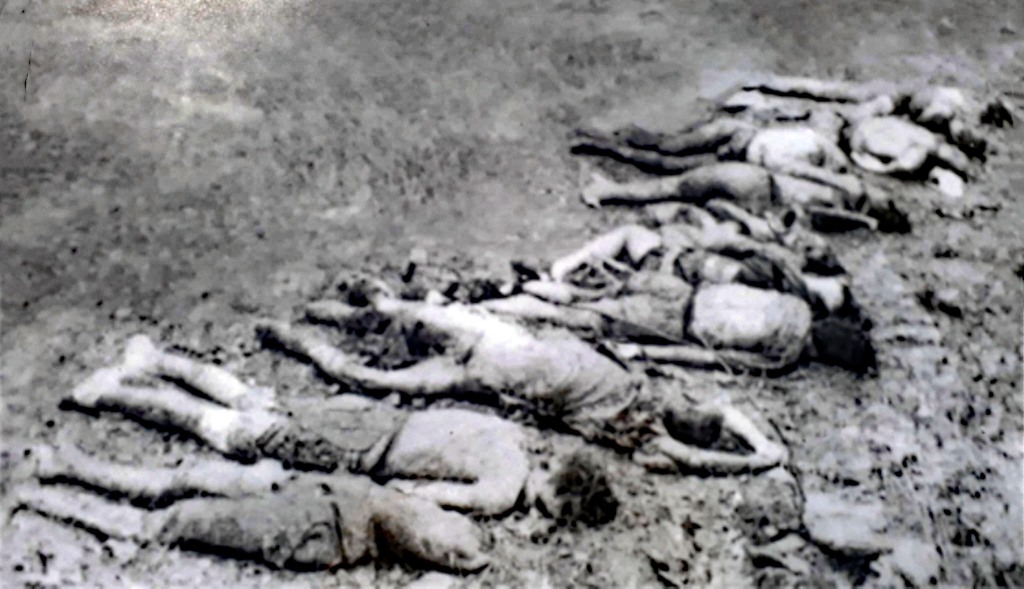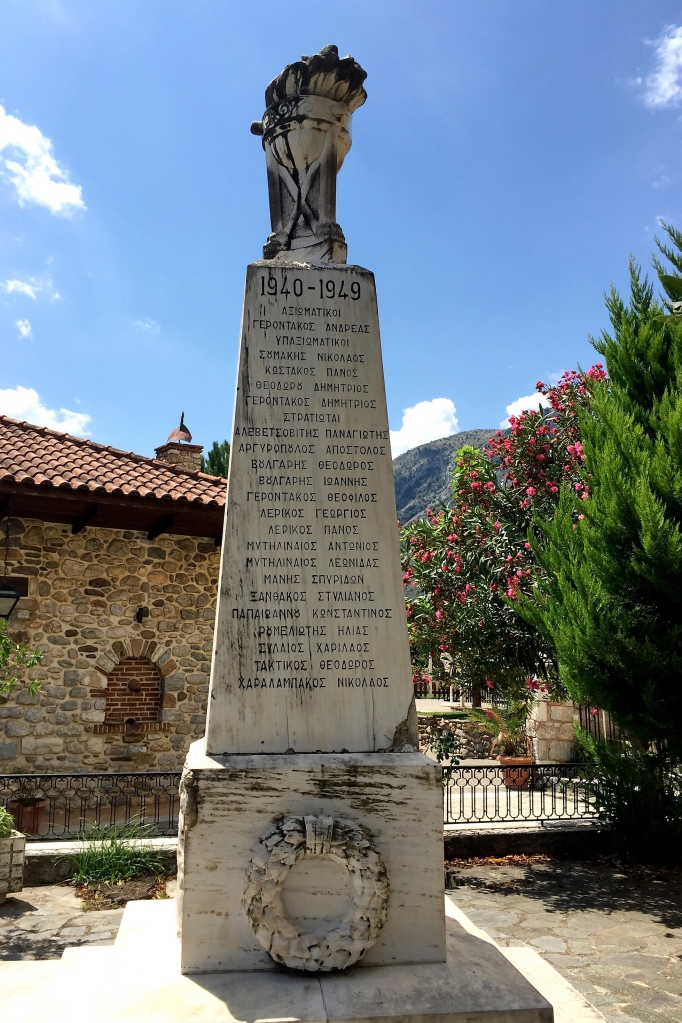The horrors of the Axis occupation of Greece (1941-1945) are beyond the comprehension, and understanding, of those who did not experience it. Military and political factors divided both country and family. The execution of thousands is a well-documented fact, and the loss of these individuals has forever changed the lives of their families.
This post is not to debate history and politics, but to remember the men and women who were executed in Mystras on October 10-11, 1944. These are not just names, but members of our families. One of them is my cousin, Panagiotis Grigoris Kostakos, of Agios Ioannis.

Panagiotis’ granddaughter, Panorea, sent me an article, The Battle of Mystra, October 10-11, 1944, which describes in detail the horrific events of that day. The Greek version can be accessed here, and the English translation here. Following is a brief synopsis of this article and the names of the casualties. Twenty four of twenty-eight young men executed were from my village of Agios Ioannis. An additional thirty-seven civilian men and women from villages surrounding Mystras were killed. May their memories be eternal.
The civil battle of Mystra occurred about 40 days after the withdrawal of the Nazi troops from Laconia. During World War II, Right and Left political parties developed in Greece, with radically different perspectives regarding the Italian-German occupation.
Right wing Security Battalion guards (Τάγματα Ασφαλείας, TA) arose in the spring and summer of 1944 against left wing EAM/ELAS guerillas. Conflicts between these parties had already begun in the summer of 1943, and escalated after Italy pulled out of Greece in September 1943. In most prefectures of the Peloponnese, the TA and EAM had limited interactions until after the Nazi withdrawal one year later in October 1944. But this was not the case in Lakonia, where EAM set up prisoner camps for”reactionary” individuals in Arna, Geraki, Georgitsi, Kremasti, Socha, Barsinikos, Tripi and the Monastery of Giatrissa (Mani).
Between January and August 1944, dozens of battles took place between ELAS and TA at various locations in Lakonia. The homes of ELAS and TA members were looted and burned by opposing forces, and reprisals taken against their families. When the Germans departed on September 3, 1944, the 800-man TA of Sparta moved to the castle of Mystras. Hundreds of local civilians who feared for their lives followed them.
An ELAS attack on Mystras, using light weapons, began the morning of October 10. Thirty ELAS fighters were killed. The next day, ELAS fired cannons onto the castle and mortars into the city, causing many civilian casualities. The TA called for a truce on the afternoon of October 11. An agreement was reached with the following terms:
- The TA was to hand over the weapons in the morning of the next day (October 12),
- Thirty TA leaders, military and civilian, were to remain in the Mystras Castle under guard until judged for their actions by representatives of the Greek government,
- All other officers and soldiers of the TA, as well as civilians, were to be released to return to their homes. No executions of battalion officers or civilians were to be committed.
The representatives of ELAS refused to draw up a document of the agreement, instead giving “the word of their military honor.” The next day, the TA’s delivered their weapons to ELAS but no men were released. Instead, they were marched to the “Bezestini,” an arena in Mystras. Along the route, riots broke out and people were killed.
Meanwhile, a platoon of TAs was stationed at Prophet Ilias in the Taygetos. When they were notified that the TA agreed to surrender their weapons, they descended from their outpost to Mystra. Their march was interrupted by ELAS guerrillas, who persuaded them to hand over their weapons to them, instead of going down to Mystra. After doing so, the ELAS forces tied them up and led them back to prison in Xerovouna, where the TA were locked up in a small farmhouse. Then, taking one by one ostensibly for interrogation, ELAS tortured and executed them all.
The names of the twenty-eight young men executed:
- Panagiotis Bogeas – Παναγιώτης Μπογέας, Lieutenant
- Nikolaos Soumakis – Νικόλαος Σουμάκης, Sargeant Major
- Panagiotis Andriopoulos – Παναγιώτης Ανδριόπουλος
- Apostolos Argyropoulos – Απποστολος Αργυρόπουλος
- Theodoros Voulgaris – Θεόδωρος Βούλγαρης
- Ioannis Voulgaris – Ιωάννης Βούλγαρης
- Dimitrios Gerontakos – Δημήτριος Γεροντάκος
- Theofilos Gerontakos – Θεόφιλος Γεροντάκος
- Dimitrios Dimakos – Δημήτριος Δημάκος
- Dimitios Theodorou – Δημήτριος Θεοδώρου
- Panagiotis Zavakos – Παναγιώτης Ζαβάκος
- Ioannis Kalogerogiannis – Ιωάννης Καλογερόγιαννης
- Ilias Kourtalis – Ηλίας Κούρταλης
- Ioannis Koufos – Ιωάννης Κουφός
- Panagiotis Kostakos – Παναγιώτης Κωστάκος
- Georgios Lerikos – Γεώργιος Λερίκος
- Alexandros Manousakis – Αλέξανδρος Μανουσάκης
- Konstantinos Markoglou – Κωνσταντίνος Μάρκογλου
- Antonios Mytilinaios – Αντώνιος Μυτιληναίος
- Leonidas Mytilinaios – Λεωνίδας Μυτιληναίος
- Grigorios Nikolopoulos – Γρηγόριος Νικολόπουλος
- Konstantinos Papaioannou – Κων/νος ΠαπαΙωάννου
- Ilias Roumeliotis – Ηλίας Ρουμελιώτης
- Athanasios Sigalos – Αθανάσιος Σιγαλός
- Harilaos Silaios – Χαρίλαος Σιλαίος
- Anastasios Stamatopoulos – Αναστάσιος Σταματόπουλος
- Panagiotis Sotirakos – Παναγιώτης Σωτηράκος
- Theodoros Taktikos – Θεόδωρος Τακτικός

The photo was taken by an ELAS guerrilla. From the article, Battle of Mystras.
These civilian women and men were also executed in Mystras:
- Eleni Agekkakou – Ελένη Αγγελάκου
- Vasiliki Leloudou – Βασιλική Λελούδου
- Athina Sigalou – Αθηνά Σιγαλού
- Maria Sotirakou – Μαρία Σωτηράκου
- Vasiliki Florou – Βασιλική Φλώρου
- Panagiota Florou – Παναγιώτα Φλώρου
- Alexandros Drivakos – Αλέξανδρος Δριβάκος, Lieutenant
- Stavros Spanopoulos – Σταύρος Σπανόπουλος, Lieutenant
- Efstratios Voulgaris – Ευστράτιος Βούλγαρης, Sargeant
- Evaggelos Pololos – Ευάγγελος Πολολός, Sargeant
- Aggelos Aggelakos – Άγγελος Αγγελάκος
- Georgios Varvitsiotis – Γεώργιος Βαρβιτσιώτης
- Anastasios Vlachos – Αναστάσιος Βλάχος
- Dimitrios Vorvis – Δημήτριος Βορβής
- Ioannis Voulgaris – Ιωάννης Βούλγαρης
- Theofilos Gerontakos – Θεόφιλος Γεροντάκος
- Nikolaos Goutos – Νικόλαος Γούτος
- Aristeidis Kakaletris – Αριστείδης Κακαλέτρης
- Panagiotis Kakaletris – Παναγιώτης Κακαλέτρης
- Efstratios Kapetaneas – Ευστράτιος Καπετανέας
- Christos Kardasis – Χρήστος Καρδάσης
- Konstantinos Kastanis – Κωνσταντίνος Καστανής
- Nikon Kastanis – Νίκων Καστανής
- Georgios Kouveliotis – Γεώργιος Κουβελιώτης
- Panagiotis Koufakos – Παναγιώτης Κουφάκος
- Spyridon Lamprinos – Σπυρίδων Λαμπρινός
- Panagiotis Manousos – Παναγιώτης Μανούσος
- Spyridon Mountzouros – Σπυρίδων Μουντζουρός
- Panagiotis Bougadis – Παναγιώτης Μπουγάδης
- Nikolaos Sotiropoulos – Νικόλαος Σωτηρόπουλος
- Georgios Floros – Γεώργιος Φλώρος
- Christos Floros – Χρήστος Φλώρος
- Athanasios Fratzis – Αθανάσιος Φρατζής
- Nikolaos Charalambakos – Νικόλαος Χαραλαμπάκος
- Athanasios Charisis – Αθανάσιος Χαρίσης
- Panagiotis Christakakos – Παναγιώτης Χριστακάκος
- Georgios Chouseas – Γεώργιος Χουσέας
The names of those killed in various wars are memorialized on War Memorials found in every Greek village. We, too, can remember and honor them.



My relatives lived in
Mystras
Markopoulos
Velikas
Bougadis